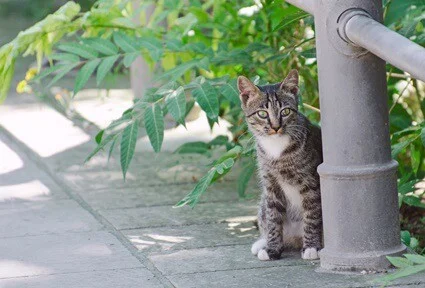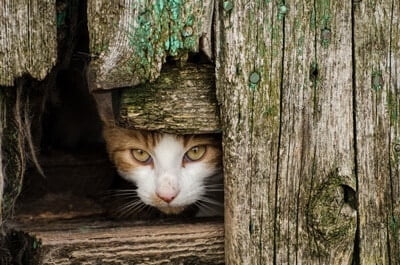“Adopt, don’t shop” is a popular refrain among cat lovers. While homeless cats deserve a loving family, feral cats are a special case as they’ve never lived with humans and are afraid of us.
Although animal rescue agents disagree, most vets believe that feral cats cannot be tamed. If a feral cat stands any chance of house training, it must be young. Older feral cats are completely wild. If you attempt domestication, it’ll be a long and arduous process with no guarantee of domestication.
You don’t need to adopt a feral cat to improve its quality of life. Consider a “Trap, Neuter, Return” (TNR) policy. You can still provide food and shelter to feral cats on your property, but you need to be aware of the risks involved.
What Is A Feral Cat?
A feral cat lives without human company. It’s believed that there are up to 100 million feral cats in the United States alone. These cats live in colonies and reproduce frequently.
If a homeless cat regularly visits your property, it’ll be tempting to take it in. Before you do so, ensure that the cat is merely stray and not feral. While stray cats can be reintegrated into domestic life, feral cats will struggle.
Differences Between Feral and Stray Cats
Stray cats are domesticated pets that find themselves homeless, either temporarily or permanently. Feral cats are wild animals, so the cat will be governed by survival instincts and behave accordingly.
You can tell the difference between stray and feral cats through their appearance and behavior:
| Feral Cats | Stray Cats |
|---|---|
| Avoid all human contact | Will approach humans for food or petting |
| Live in groups and colonies | Sleep, live, and wander alone |
| Move silently and stealthily | Walk tall with a prominent tail |
| Never verbalize unless scared or angered | Will meow to ask for food or attention |
| Well-groomed, sleek fur | Dirty or disheveled coat |
| Primarily nocturnal | Wandering around by daylight |
| Ignore toys or food | Investigate toys or food |
Feral cats may also have a clipped ear tip, which means that the cat has previously been captured, neutered, and returned to the wild. Feral cats reproduce often, and TNR attempts to control the population.
According to The Journal of the American Veterinary Medical Association, 75% of feral kittens live less than 6 months. Without human assistance, they’re at risk of accidents and illness.
If you capture them early enough, a feral kitten may be tamable.
Helping vs. Domesticating Feral Cats
You can assist feral cats without bringing them into your home. Leave food outdoors and offer shelter in cold temperatures. Open your garage doors or strategically place boxes outside.
There are risks associated with this behavior, though. Feral cats rarely travel alone. Once a feral cat discovers that your property is welcoming, it’ll be claimed as territory. The cat will mark and invite other feral cats to join it.
Animal control centers recommend a “trap, neuter, release” approach to feral cats. This involves trapping the cat and taking it to a vet. The cat will then be spayed or neutered, then released back into the wild. This may seem cruel, but it’s an act of kindness. Feral cats are not cut out for domestication.
To trap a feral cat:
- Learn the cat’s behaviors and timetable of activity
- Purchase a large cat trap
- Leave food in the trap
- Spring the trap when it is safe to do so
Don’t take the cat to a shelter after it’s been trapped. Most cat shelters are already overpopulated and lack the capacity to care for feral cats. In addition, feral cats are unsocialized, potentially sick or diseased, and will fight with other cats. Consequently, many shelters euthanize feral cats.
If you want to resolve feral cat problems, call a local animal control or wildlife rehabilitation center.
Can You Tame Feral Cats?
According to The Journal of Feline Medicine and Surgery, opinion is divided on this subject. Animal rescue workers say yes, and veterinarians say no. To stand any chance of taming a feral cat, it must be very young.
The longer a cat lives on the streets, the more independent it will become. Feral cats that are more than a year old will be almost impossible to approach.
Never bring a feral cat into your home if you already have pets. Feral cats will be aggressive and belligerent. Even if the cat does not attack your pets, it may carry parasites and diseases.
Attempting to domesticate a feral cat will require experience in handling difficult cats.
How To Domesticate a Feral Cat
You’ll need to trap the feral cat as it will not approach you willingly. This should be a warning that the cat has no intention of being domesticated.
It may take several days and different techniques to trap a feral cat as it may have encountered traps before. Once you’re ready to bring the cat indoors, prepare for a long and arduous journey.
This will comprise of five different steps:

Assign Territory
You’ll need one room that the cat won’t leave, as you can’t allow a feral cat to wander free around your home. Set this room up with everything the cat needs, including hiding places, food, and water.
Feral cats aren’t used to being indoors, so the cat may act destructively. Remove anything of value from the cat’s new territory. The cat will mark with urine a lot. Allow this, at least for a while, as it’ll make them feel more secure.
Leave the cat in the room, but spend time with it. The cat needs to get used to being around humans. It’s advisable to lock the cat in a carrier while you’re in the room to reduce the risk of being scratched or bitten.
Focus on speaking as cats recognize their owners by voice. Don’t attempt to handle the cat. Speaking to the cat regularly will create a sense of kinship. Sitting in the room and reading aloud will enhance this recognition.
Don’t get too emotionally attached to the cat during this stage because you’re unlikely to be able to tame it.
See a Vet
Feral cats carry diseases, may be pregnant, or have parasites.
Call your local vet and ask if they’ll treat feral cats. Some surgeries refuse to do so due to safety concerns. Check if the surgeries charge for their services, as some vets will work with wildlife pro bono.
When you take the cat to a vet, they’ll check if the cat is:
- Microchipped as the cat may be a long-lost stray
- Pregnant
- Living with a contagious disease
- Dehydrated or malnourished
- Infested with fleas, mites, or ticks
Blood and urine samples will be taken, and the vet will likely run x-rays to check for any broken bones. This is why it’s important to check if the surgery charges for their services as pet insurance won’t cover feral cats.
If the cat isn’t already spayed or neutered, this is critical. Feral cats survive through a constant cycle of mating. A feral cat in heat will yowl at night, increasingly desperate to escape the home.
If the feral cat is given a clean bill of health, you can discuss the next steps. Most vets will recommend returning the cat to the wild, and if you defy this advice, a vet may decline to accept the cat as a regular patient.
Build Trust with Food
Step up the bonding process by talking to the cat and holding off on handling.
The way to gain a feral cat’s trust is through food. Regular access to feeding is why cats first approached humans for care 10,000 years ago. It may take a while to find food that the cat enjoys.
Be prepared for stomach upsets as the cat’s digestion won’t be used to cat food. Feral cats survive by eating from trash cans and hunting live prey. Cat food will provide unfamiliar vitamins and minerals.
Feed the cat at the same time each day as this routine will build a sense of trust and security. At first, leave the food and walk away. After a few days, remain in the room while the cat eats. If it does so, the cat is starting to trust you.
In addition to food, you could offer toys for stimulation, but don’t be surprised if the cat ignores them. Feral cats have never been socialized to play, so their instincts and lifestyle are entirely geared toward survival.

Litter Training
Before too long, you’ll need to litter train your feral cat. Again, this is going to take time. Feral cats are used to eliminating anywhere they please, usually to mark territory.
As your feral cat is used to eliminating outside, bring a little nature to its litter box. Sprinkle some familiar-smelling soil or cat-safe flowers into the litter. You can also pick up spray from a pet store that encourages elimination.
Start by creating a clear path to the litter tray, especially after eating. Create a pathway using boxes or baby gates if necessary. You want the cat to make its own way to the litter box.
If necessary, you can try placing the cat in the tray, but this may result in scratches. Wear gloves and long sleeves for your protection, holding the cat away from your face.
Even if litter training is successful, it can take 8-10 weeks. Never rush a feral cat in any act of domestication training as you’re attempting to overcome powerful, primitive instincts.
Attempt Handling
Eventually, you’re going to need to handle the feral cat. If the cat remains wary of you, it’ll never adapt to life as a domesticated pet. It will spend its life afraid of everything in your home, including you.
Handling a cat that does not want to be picked up is never easy. The danger is magnified with feral cats as they won’t hold back if they feel threatened. Feral cats are used to fighting for their lives.
Get down to the cat’s level and keep a safe distance. Take one step closer to the cat, watching its reaction carefully. If the cat displays any of these behaviors, walk away:
- Hissing or growling
- Shrinking into itself
- Puffing tail and body fur
- Swiping with claws
- Yowling
It may take months before a feral cat permits even the most limited handling.
Start with gentle petting around the back. Don’t attempt to touch the cat’s face until it enjoys being touched. Picking up the cat is the final step of the process.
Even if your feral cat accepts handing from you, this will be a unique situation. The cat will still be terrified of other people. Factor this into your decision-making about whether to keep the cat. If you adopt a feral cat, you should avoid visitors and houseguests for a while.
Feral cats are difficult to domesticate. If you attempt the process, prepare for a frustrating experience. An inability to domesticate a feral cat is no failure on your part.


Hi!
Love this article 🙂 I went blindly into rescuing a ferrel cat. I think His wildness may have kicked my Instincts to not rush things and protect myself into gear. Not that I didn’t get my fair share of scratches along the way and still get a little swipe now and again. My guy was worth it all and it’s been 13 years since we brought Him in. What a smart, loyal and loving Boy we have. It was definitely a journey that a true animal lover can get through but patience it the key for the first year. Also leaves and grass from outside in the litter box help when they first come in ❤️
Have three neutered ferals. Two of them are very loving but one is very scared and will not allow petting. The other two are very affectionate. Rolling on back ..want to be petted and give love bites. They eliminate outside but come in often during the day. They only trust their mama. The third scaredy cat is still not warming up yet although she will come in the house to explore. They were not last summer under our shed. After they were weaned I fed and watered them. I insulated A pet kennel with Styrofoam for winter anD covered with a tarp. They sleep outside. They hunt at night I believe. They are awaiting for me in the morning. will keep you posted on the third cat I believe she will come around by end of summer…Linda s
I am in the process of domesticating a feral now. The cat has lived on our porch for 8 years. She is getting older and the weather is getting to her so we decided to try. She was checked out by a vet. She was already neutered before she came to us so I guess she is about 9 years old. She does let my son pet her a lot. She adjusted to food well and litter well. She is down in the basement and started out in the bathroom only but now has full roam of the basement. She started coming off the basement steps and we have a screen at the top to separate her from our indoor cat. She is still pretty skittish but the next step will be to eventually remove the screen. I am afraid to do that because I am afraid she might run and hide somewhere and not come out. Not sure when I will know when the time is right. I think her and my indoor cat wont fight, they will just run in opposite directions. Would welcome any suggestions. Thanks.
On the 1st of September a feral cat was in my yard i discovered it when it was giving birth I don’t know what was wrong with it but it was yawling and had a kitten failing to come out, I took my gloves and assist it until the kitten got out, so all this time i was giving it food and today it’s not there and the two kittens, is it going to come back or it’s not. I had developed bond with it, like it was never running away when am around and when I gave it food it would come and eat and not run away from me.
Is it possible to tame a feral cat?
Thank you so much for the video & article. I rescued a feral with 5 very young kittens 2 1/2 yrs ago. I really didn’t know what I was doing but got some help from a friend who did TNR & cared for the many alley cats on the street. I put mama & her kittens in my small office room which has a window & a futon sofa. I brought in a litter box & a water & food bowl & placed a cat gym under the window. At first she only nursed her kittens under the futon but as they got older she would lay out in the middle of the floor & nurse them while I was in the room. She used the little box right from the start & I had the privilege of watching her teach her kittens how to use it! Cutest thing ever! All this time I have never been able to touch her. My friend came over & trapped her again to take her in for her spay & she was given a clean bill of health. They said she was about 3 yrs old. Everything I have read about feral cats only half fits her. She’s quiet other than the occasional hiss & she’s very wary of humans, always backing away from any ‘threat’ of touching. On the other hand, she readily used the litter box, nursed her kittens in front of me & would eat with me in the room, loves to play with toys & if I’m involved on my computer when she wants to eat – she will stand up at my chair & tap me on the arm! Lately when I hold my fist out to her she will rub the side of her mouth & cheek on it. So is she feral or just lost her home at a very early age? I thought she was feral because it’s taken so long to get to where we are but many of the feral criteria don’t fit her so I’m confused. Any thoughts?
The behavior you’ve described indicates that this cat may not be entirely feral but could be a stray or a lost pet who has reverted to more feral behavior due to her circumstances.
Feral cats are typically born and raised in the wild, or have lived in the wild for a significant period, and are not accustomed to human interaction. They tend to avoid humans, often do not use litter boxes, and are generally very self-reliant. Your cat, however, shows signs of having had human contact in her past. Her use of the litter box, comfort in nursing her kittens in your presence, and playful interaction with toys are behaviors more commonly associated with domesticated cats.